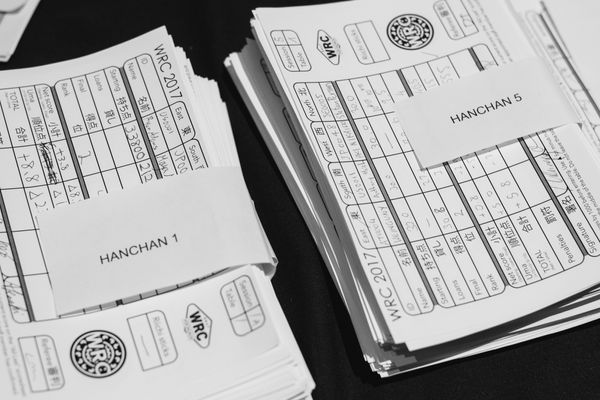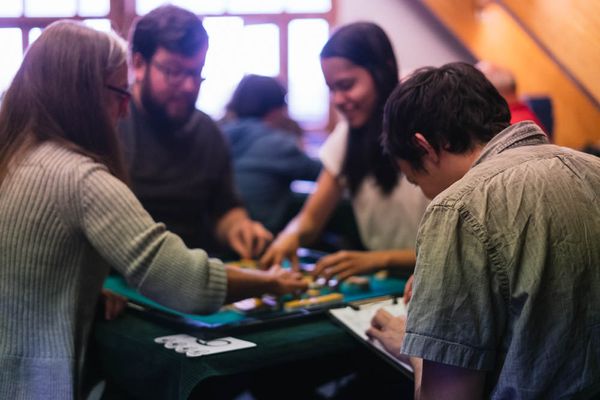I told you not to go for Kokushi

We’ve all been there: you’re dealt a hand with a lot of yaochuu tiles — ones, nines, and characters — and you find yourself asking, “Do I go for the stupid thing?”
Despite being one of the most common yakuman, Kokushi Musou still boasts a wide arsenal of ways to betray you. Those last few tiles never seem to come; your discards give away your strategy; you have no real defense; and if the other players discard all four of a tile you need, you can’t easily switch to something else.
So when do you go for it? An advanced player might say that you can do it when you start with 11 different yaochuu tiles, but if you’re playing a 3-player game on Tenhou, you can do it with 8. Aside from that, are there any situations in which it’s worth being more aggressive? Are there any strategic uses for the forced redeal (kyuushukyuuhai)? In this post, I will look at the strategies employed by players when they had the chance to go for Kokushi. What choice did they make? Were they successful? What situational information influences the decision to be more or less aggressive?
As usual, this data comes from querying the Tenhou statistics database maintained by bps. For this post, I looked at just over 9000 hands, each of which started with 9 or more distinct yaochuu tiles. All results came from 4-player games in the Houou lobby.
First off, let’s identify the strategies you can use when dealt a lot of yaochuu tiles:
- Redeal the hand (kyuushukyuuhai)
- Go for yakuman
- Try to make some other hand
Now let’s look at what choices people made when dealt 9, 10, 11, or 12 different yaochuu tiles:
| Starting Yaochuu | Redeals | Kokushi Attempts | Other Attempts |
| 9 | 82.02% | 4.72% | 13.26% |
| 10 | 44.16% | 31.59% | 24.25% |
| 11 | 10.67% | 64% | 25.33% |
| 12 | 0% | 66.67% | 33.33% |
| Starting Yaochuu | Kokushi Gets | Other Agari |
| 9 | 5.5% | 13.26% |
| 10 | 13.55% | 1.96% |
| 11 | 35.42% | 0% |
| 12 | 50% | 0% |
What about speed? How many turns does it take to complete your Kokushi?
| Starting Yaochuu | Average Turns to Kokushi | Std Dev |
| 9 | 11.25 | 3.46 |
| 10 | 10.23 | 3.44 |
| 11 | 9.18 | 4.11 |
| 12 | 4 | 0 |
| Progress to Kokushi | Average Turns since Previous Tile | Std Dev |
| 10th tile | 4.3 | 2.47 |
| 11th tile | 4.91 | 2.93 |
| 12th tile | 4.07 | 2.96 |
| 13th tile | 2.24 | 2.26 |
We can assume from this data that it makes sense to go for Kokushi when you start with at least 11 of the tiles needed. A success rate of 1 in 3 is phenomenal for a 4-player game. Anything less than 11 and you might as well force a redeal. Or should you? Even a 10% chance of success could be worth the tremendous Yakuman payout. We can see that people did sometimes try for Kokushi even when dealt only 9 or 10 of the tiles they needed. Since this is the houou table, we can assume that any silly “limit maker” or other showy playstyles don’t come into play here. There must have been some situational factors that made these players decide the risk was worth the reward. If we take a look at these factors, maybe we can identify if there is a consensus on when to be aggressive and when to play it safe.
One obvious factor would be placement by score. Here’s the frequency of forced redeals separated by place:
| Score Placement | Ryuukyoku with 9 tiles | Ryuukyoku with 10 tiles |
| 1st | 84.52% | 51.52% |
| 2nd | 84.14% | 49.61% |
| 3rd | 84.27% | 43.54% |
| 4th | 73.18% | 32.29% |
How about early vs. late game? Here’s the frequency of forced redeals separated by phase:
| Phase of game | Ryuukyoku with 9 tiles | Ryuukyoku with 10 tiles |
| Early | 83.75% | 39.69% |
| Early Mid | 82.38% | 42.32% |
| Late Mid | 82.20% | 44.79% |
| Late | 79.29% | 50.94% |
What about seat? Does being Oya make players more or less likely to try for Kokushi? Here’s the frequency of forced redeals separated by seat:
| Seat | Ryuukyoku with 9 tiles | Ryuukyoku with 10 tiles |
| East | 90.36% | 62% |
| South | 81.8% | 43.74% |
| West | 79.24% | 35.7% |
| North | 76.57% | 34.94% |
So, to recap:
- Go for Kokushi when you start with 11 or more tiles. The odds are actually better than your odds with a typical starting hand.
- Go for Kokushi with 10 tiles only when the points are important in the long run — for example, in a tournament where points carry over from each game.
- Don’t attempt Kokushi if you only have 9 tiles.
- Players who are in a position to take risks will often go for Kokushi with “bad” hands.
Finally, feel free to post any interpretations you might have for the data shared here. I’m sure there are quite a few strategic angles that I’ve overlooked. I also haven’t covered defense. Maybe that will be a future article?



